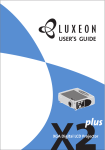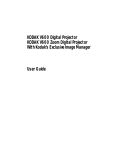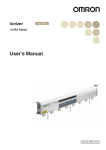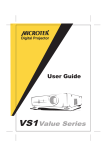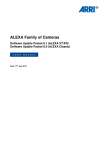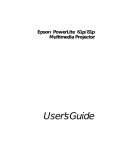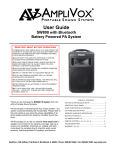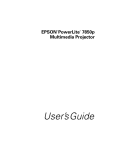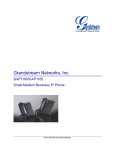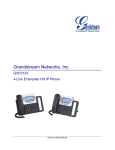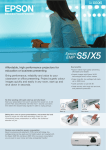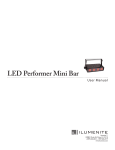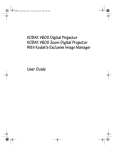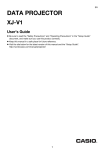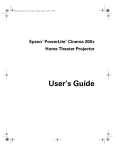Download LCD Projector USER GUIDE
Transcript
LCD Projector with Image Manager Feature USER GUIDE FCC Warning This equipment has been tested and found to comply with the limits for a Class A digital device, pursuant to part 15 of the FCC rules. These limits are designed to provide reasonable protection against harmful interference when the equipment is operated in a commercial environment. This equipment generates, uses and can radiate radio frequency energy and, if not installed and used in accordance with the instruction manual, may cause harmful interference to radio communications. Operation of this equipment in a residential area is likely to cause harmful interference in which case the user will be required to correct the interference at his own expense. Canada This class A digital apparatus complies with Canadian ICES-003. Cet appareil numérique de la classe A est conforme à la norme NMB-003 du Canada. Safety Certifications UL, CUL, TUV EN 55022 Warning This is a Class A product. In a domestic environment it may cause radio interference,in which case the user may be required to take adequate measures. The typical use is in a conference room, meeting room or auditorium. Declaration of Conformity Directive 89/336/EEC, Amended by 93/68/EEC EMI: EN 55022 (1992) Class A EMC: EN 50082-1 (1992) IEC 801-2, IEC 801-3, IEC 801-4 Directive 73/23/EEC, Amended by 93/68/EEC Safety: EN 60950: 1992 + A1 + A2 + A3: 1995 March, 2000 Taiwan BSMI Table of Contents Introduction ............................................................................2 How And Where To Get Help .................................................3 How To Get Help .................................................................................... 3 Where To Get Help ................................................................................ 4 Projector Features .................................................................5 Connecting the Projector ......................................................6 Starting the Presentation ......................................................7 Using the Remote Control and Keypad ...............................9 Positioning the Projector ....................................................10 Using Image Manager .......................................................... 11 Adjusting the Display and Volume .................................................... 12 Setting Up the Image Source ............................................................. 13 Selecting a Language ......................................................................... 14 Checking the Status ........................................................................... 15 To reset lamp hours ............................................................................ 15 Turning Off the Projector .................................................................... 15 Transporting the Projector ..................................................16 Maintenance .........................................................................17 Changing the Lamp Module ............................................................... 17 Cleaning the Projection Lens ............................................................ 18 Cleaning the Exterior Case ................................................................ 19 Cleaning the Air Filter ......................................................................... 19 Troubleshooting ...................................................................20 Power Indicator ................................................................................... 20 Image Quality ...................................................................................... 21 Sound ................................................................................................... 22 Remote Control ................................................................................... 23 Lamp .................................................................................................... 23 Safety ....................................................................................25 Safety Definitions ................................................................................ 25 Projector Safety .................................................................................. 25 Battery Safety ...................................................................................... 26 Specifications .......................................................................27 1 LCD Projector User Guide Introduction The easy-to-use LCD Digital Projector offer superb image quality at an affordable price. Built into the LCD Digital Projector with Image Manager feature. With this feature, you can select the image display setting best suited for your specific presentation material and projection environment. In only minutes you can have your LCD Digital Projector ready to go. Just connect the projector to an image source such as a computer, DVD, VCR, or digital camera. If you are familiar with connecting and using digital projectors, refer to the Quick Start Guide included with the projector. If not, follow the directions in this user guide to connect your projector and run your presentation. What’s in the Box Make sure that all of the following components were included with the projector. Contact your dealer immediately if anything is missing. • Soft carry case • Lens cap • Analog RGB (15 Pin HD) cable • S-video cable • Composite video cable • Stereo audio cable – 1/8” mini-plug • Power cord • User Manual • Quick Start Guide • Remote control • MACINTOSH adapter 2 How And Where To Get Help How And Where To Get Help This section describes the most efficient and effective way for you to receive technical support and customer service, should you need it. How To Get Help Before you call Service Center, please refer to the Troubleshooting section of this manual. Seller provides technical support and customer service through a network of authorized dealers. Contact seller’s for the location of the nearest Authorized dealer. When you call seller, or an authorized service center, please be prepared to provide the following information: 1. Product: 2. Serial Number: 3. Place Of Purchase: Company Name Contact Address Telephone Fax 4. Date Of Purchase: Note: Please keep an original copy of the invoice or receipt from the purchase of your multimedia projector as proof of purchase. 5. What peripheral equipment is connected to your multimedia projector? Brand Model Number __________________________________________________________________ ___________________________________________________________________ ______________________________________________________________________________ ______________________________________________________________________________________________________________________________________________________________ 6. Description Of Problem: _______________________________________________________________________________ ________________________________________________________________________________ ________________________________________________________________________________ Note: If you need help using third-party peripherals or software with your multimedia projector, please refer to the documentation provided with the third party peripheral or software or contact the manufacturer for technical support or customer service. 3 LCD Projector User Guide Where To Get Help Your authorized dealer Note: Please record the contact information for the authorized dealer from which you purchased your multimedia projector. Company Name Contact Address Telephone Fax Home Page E-Mail Hours of Operation 4 Projector Features Projector Features keypad remote control sensor focus ring zoom ring ( Zoom model only) foot release button (2) connection panel adjustable feet connection for optional Kensington Lock 5 LCD Projector User Guide Connecting the Projector PC / MAC PC/MAC connection to the computer monitor prot S-Video to the S-Video out port S-VIDEO VIDEO AUDIO AV Video to the Composite video out port ~ 100V Audio to the source’s Audio out port 240V Power cord connection to an electrical outlet The cables are color coded to assist you with making the connections. When you connect the power cable to the projector, the Power light on the keypad begins to blink. You can connect more than one image source at a time. Use the Setup tab on the menu screen to select which image source you want to view. See “Setting Up the Image Source” on page 13. If you are using an older MACINTOSH computer, you might need to use the MACINTOSH adapter that was included with your projector. Warning:Always turn off the image source (computer or video source) and projector before connecting or disconnecting cables. 6 Starting the Presentation Starting the Presentation We recommend turning on the projector and image sources in the order listed here. Note: You might not be using all of these components for your presentation. • Video source such as VCR, DVD or digital camera. • Audio source if different from your video source or computer • Projector • Computer 1. Connect the signal cable to the computer or video source. 2. Connect the power cord to the projector and to a power source. The Power light begins to blink. 3. Turn on the presentation components in the order listed. To turn on the projector, remove the lens cap and press the Power button on either the remote control or the keypad. Power button POWER MENU ADJUST ENTER NEXT The Power light stays a steady green when the lamp comes on. Either the title screen or the image from the image source appears. Note: Many laptop computers do not automatically turn on their external video port when another display device is connected. Refer to your computer’s user guide for the function key or command that activates the port. MAC users may need to turn on SimulSCAN or monitor mirroring. Refer to the computer manual. 7 LCD Projector User Guide 4. Position the projector by using the adjustable feet on the bottom of the projector. Press the foot release buttons on the front of the projector to raise or lower the feet. 5. Turn the focus ring to focus the image and turn the zoom ring (zoom model only) to zoom in or out on the image. 6. Make any necessary image adjustments by using the on-screen menus. Press the Menu button to view the menu choices. Use the Adjust + - buttons to go to the desired tab. Press the Menu button again to dismiss the menus.Go to the header tab to select the type of content in your presentation. See “Using Image Manager” on page 11. Go to the Adjust tab to adjust brightness, contrast, color (video only) and tint (video only). See “Adjusting the Display and Volume” on page 12. Go to the Setup tab to select the image source, type of projection, video AGC (Automatic Gain Control), video format and to adjust frequency, tracking and the image position. See “Setting Up the Image Source” on page 13. 7. Run your presentation from your computer or video source. 8 Using the Remote Control and Keypad Using the Remote Control and Keypad The remote control and projector keypad perform similar operations, with one exception-the remote control has a volume control. Power - turns the projector on and off POWER Menu - display the menus on the projected image Enter - selects an option button Next - hightlights the next feature in the menu Adjust - navigates between tabs; moves a highlighted slider bar left or right; and moves between options for features like Source and Projection MENU ADJUST ENTER NEXT Key pad Volume - increase or decreases volume Remote Control Press and hold the buttons to make repeated moves and adjustments. 9 LCD Projector User Guide Positioning the Projector The projector should be at least 2.5 feet (.9 m) from the screen but no more than 32 feet (10 m) away from the screen. Fixed lens model - screen sizes are: Distance Width x Height Diagonal 3' (.9 m) 18 x 13" (.5 x .3 m) 22.5" (.6 m) 5' (1.5 m) 31 x 23" (.8 x .6 m) 38.5" (1.0 m) 6.5' (2.0 m) 40 x 30" (1.0 x .8 m) 50" (1.3 m) 8' (2.4 m) 48 x 36" (1.21 x .9 m) 60" (1.5 m) 9' (2.8 m) 56 x 42" (1.4 x 1.1 m) 70" (1.8 m) 10.5' (3.2 m) 64 x 48" (1.6 x 1.21m) 80" (2.0 m) 12' (3.6 m) 72 x 54" (1.8 x 1.4 m) 90" (2.3 m) 13' (4.0 m) 80 x 60" (2.0 x 1.5m) 100" (2.5 m) 14.5' (4.4 m) 88 x 66" (2.2 x 1.7 m) 110" (2.8 m) 16' (4.8 m) 96 x 72" (2.4 x 1.8m) 120" (3.0 m) 17' (5.2 m) 104 x 78" (2.6 x 2.0 m) 130" (3.3 m) 18' (5.6 m) 112 x 84" (2.8 x 2.1m) 140" (3.6 m) 20' (6.0 m) 120 x 90" (3.0 x 2.3 m) 150" (3.8 m) 33' (10 m) 200 x 150" (5 x 3.8 m) 250" (6.4 m) Zoom lens model - screen sizes are: Distance 10 Width x Height Diagonal 3' (.9 m) 13~17" x 10~13" (.33~.43 x .25~.33 m) 16~21" (.4~.5 m) 5' (1.5 m) 22~28"x 16~19" (.55~.71 x .41~.48 m) 27~35" (.7~.9 m) 6.5' (2.0 m) 29~38"x 22~28" (.74~.97 x .56~.71 m) 36~47" (.9~1.2 m) 8' (2.4 m) 34~46"x 26~32" (.86~1.2 x .66~.81 m) 43~57" (1.1~1.5 m) 9' (2.8 m) 41~54"x 31~40" (1.0~1.4 x .79~1.0 m) 51~67" (1.3~1.7 m) 10.5' (3.2 m) 46~61"x 35~46" (1.2~1.5 x .89~1.2 m) 58~76" (1.5~ 1.9m) 12' (3.6 m) 53~69"x 40~52" (1.3~1.8 x 1.0~1.3 m) 66~86" (1.7~2.2 m) 13' (4.0 m) 58~76" x 44~57" (1.5~1.9 x 1.1~ 1.4m) 73~95" (1.9~2.4 m) 14.5' (4.4 m) 64~84" x 48~62" (1.6~2.1 x 1.2~1.6 m) 80~105" (2.0~2.7 m) 16' (4.8 m) 70~91" x 53~69" (1.8~2.3 x 1.4~1.8 m) 88~115" (2.2~3.0 m) 17' (5.2 m) 74~99" x 57~74" (1.8~2.5 x 1.4~1.9m) 95~124" (2.4~3.1 m) 18' (5.6 m) 82~107" x 88~114" (2.0~ 2.7 x 2.2~2.9 m) 103"~134" (2.6~3.4 m) 20' (6.0 m) 88~114" x 66 ~86" (2.2~2.9 x 1.7~2.1m) 110~143" (2.8~3.6 m) 33' (10 m) 147~192" x 110~144" (3.7~4.9 x 2.8~3.7 m) 184~240" (4.7~6.1 m) Using Image Manager Using Image Manager With one click, Image Manager lets you choose the best image settings for your presentation type. Important:The Image Manager settings work best if you select Reset from the Adjust tab each time before selecting an Image Manager setting. 1. Press Menu and use the Adjust + - buttons to move to the tab. 2. Press Next to move to the appropriate Image Manager feature. 3. Press Enter to select that feature. 4. Press Menu to dismiss the menu or wait for the menu to close (about 15 seconds). Photos (PC) matches the higher contrast found on a standard PC monitor. This feature is best for: • images created on a PC • images from a digital camera • a starting point for video input. Photos (MAC) matches the lower contrast found on a standard MACINTOSH monitor. It is generally used for images created on or for a MACINTOSH. This setting also works well with a PC if you are using higher than normal contrast PC images. Rich Colors results in an image with deep contrast and saturated vibrant colors. It is generally used under bright lighting conditions. This setting works well to enhance colors of certain graphics and it may be useful when images created for a MACINTOSH are displayed from a PC. Spreadsheets results in an image with contrast between a PC and MACINTOSH monitor. It is generally used for text-rich tables, such as financial displays. This setting factors in ambient light, subject matter, and personal preferences to deliver the right balance of contrast and brightness. Graphics delivers the high contrast needed to project graphics and text against solid colored backgrounds. 11 LCD Projector User Guide Adjusting the Display and Volume The features available on the Adjust tab depend on your image Note: We recommend using the Image Manager to optimize the display. Then, if further adjustments are needed, use the brightness and contrast settings on the Adjust tab. 1. Press Menu and use the Adjust + - buttons to move to the Adjust tab. 2. Use the Next button to move to the feature that you want to adjust. 3. Use the Adjust + - buttons to move the slider bars. If you wish to return to the factory default settings, use Next to highlight Reset and press Enter. Note: The volume can also be adjusted from the remote control. Brightness controls the intensity of the image. Contrast controls the degree of difference between the lightest and darkest parts of the image. Color controls the saturation of the colors. Tint controls the red-green color balance. 12 Setting Up the Image Source Setting Up the Image Source The features that are available on the Setup tab depend on the type of image source that you are using. 1. Press Menu and use the Adjust + - buttons to go to the Setup tab. 2. Use the Next button to select a feature. 3. Use the Adjust + - buttons to select an option for the selected feature. If you wish to return to the factory default settings, use Next to highlight Reset and press Enter. Source options are computer, video and S-video. When you change sources, a source status message appears indicating if the projector is receiving a signal from that source. Signal is received: Computer No signal: Computer - No Input 13 LCD Projector User Guide Projection options are front, rear and ceiling. • Front projection is used for projecting straight ahead onto a screen. • Rear projection reverses the image if you wish to project from behind the screen. • Use ceiling projection when you attach the projector to a permanent ceiling bracket. H Position and V Position adjustments are available only for images from a computer. Adjust Frequency and Tracking of images from a computer until the image is evenly spaced, fuzzy vertical lines disappear, or the projected image is as wide as the menu. Video Format refers to the height and width ratio of the projected image. The 4:3 ratio is the standard format. Use the 16:9 ratio when projecting wide screen (anamorph) movies in 16:9 format. We recommend leaving AGC (Automatic Gain Control) turned on. When it is turned on, the image is automatically adjusted if the video signal is too strong or too weak. Selecting a Language The on-screen menus can be displayed in seven languages. 1. Press Menu and use the Adjust + - buttons to go to the Language tab. 2. Press Next to highlight the desired language. 3. Press Enter to select the language. 14 Checking the Status Checking the Status The information displayed on the Status tab depends on the type of image source you use. The Reset Lamp Hours feature is the only item that can be adjusted on this screen. Refer to the Lamp Hours Used when you want to know how much longer your lamp will last. Estimated lamp life expectancy is 2,000 to 4,000 hours. Important:Only reset the lamp hours after you have installed a new lamp. To reset lamp hours 1. Press Menu and use the Adjust + - buttons to go to the Status tab. 2. Press Next to highlight Reset Lamp Hours. 3. Press Enter. The Lamp Hours Used number resets to zero. Turning Off the Projector Turn off the projector and image sources in the order listed here. Note: You might not be using all of these components for your presentation. • Computer • Projector • Audio source if different from your video source or computer • Video source such as VCR, DVD or digital camera. To turn off the projector: 1. Press the Power button on the keypad or remote control. A confirmation screen appears. 2. Press the Power button again to confirm. The lamp turns off immediately but the fan continues to run until the projector cools down. The Power light continues to blink after the projector has cooled and as long as the live power cord is connected to the projector. 15 LCD Projector User Guide Transporting the Projector When you place the projector in the carrying case make sure the lens is positioned inside the lens notch of the foam insert. Secure the projector with the velcro strap. Velcro Strap Lens Notch Foam Insert Velcro Strap Important:The carrying case provided with the projector is not designed to be checked through baggage. If you can not hand carry this projector make sure it is packed properly to prevent damage. The warranty does not cover damage from improper handling. 16 Maintenance Maintenance Changing the Lamp Module Important:The lamp in the LCD Digital Projector contains trace amounts of mercury. Some governments require special disposal of lamps containing mercury. Dispose of lamps in accordance with the law and any applicable local regulations. The lamp module should be replaced with a certified replacement part. To order a new lamp, contact your local dealer. After you have changed the lamp module, make sure that you reset the lamp counter. See “To reset lamp hours” on page 15. Warning: When replacing the lamp, be sure to turn off the power and unplug the power cord. To avoid burns, wait 30 minutes before opening the lamp module door. Warning: When you open the lamp module door, be careful to not touch the hot surfaces inside. Warning: Do not loosen or remove any screws other than those on the lamp module door and the lamp module. Doing so may result in electric shock. To replace the lamp module: 1. Turn off the projector and let the projector cool for at least 30 minutes. The fan continues to run after the projector has been turned off. 2. Unplug the power cord from the projector. 3. Turn the projector upside down. With a flat head screw driver, loosen but do not remove the slotted screw in the lamp module door. 4. Lift up on the screw side of the lamp module door. Then carefully remove the lamp module cover. 17 LCD Projector User Guide 5. Loosen the two slotted screws on the lamp module bracket. 6. Gently lift and pull up on the metal wire to remove the lamp module. Caution: Do not touch the glass portion of the new lamp module with your hands or allow it to touch other objects as this may damage it and shorten its operational life. Caution: Do not drop the lamp module as the glass may shatter and cause injury. 7. Carefully place the new lamp module into the projector, with the glass portion facing left. Make sure that it is inserted securely and that the two location holes match the two location pins of the inner engine case. Tighten the slotted screws. 8. Replace the lamp module door and tighten the screw. 9. Reset the lamp usage counter. See “To reset lamp hours” on page 15. Important:The only time that you should reset the counter is after you have replaced the lamp module. Cleaning the Projection Lens 1. Turn off the projector and allow it to cool. 2. Remove the lens cap. 3. Apply a non-abrasive camera lens cleaner to a soft, dry cloth. Caution: Avoid using an excessive amount of camera lens cleaner. Do not use abrasive cleaners, solvents or other harsh chemicals as they might scratch the lens. Do not spill any camera lens cleaner on the exterior case as it may fade, deform or melt the exterior case. 4. Lightly wipe the cleaning cloth over the lens. 5. If you do not intend to use the projector immediately, replace the lens cap. 18 Cleaning the Exterior Case Cleaning the Exterior Case 1. Turn off the projector and allow it to cool. 2. To remove dirt or dust, gently wipe the exterior case with a soft, dry, lint-free cloth. 3. To remove stubborn dirt or stains, moisten a soft cloth with water and a neutral detergent and gently wipe the exterior case. Caution: Do not use alcohol, benzene, thinner or other chemical cleaners which may fade, deform or melt the exterior case. Do not apply the detergent solution to the projector lens as it may scratch the lens. Cleaning the Air Filter To ensure proper ventilation inside your multimedia projector, the air filter should be periodically cleaned. More frequent cleaning may be required if you use your projector in a dusty or dirty environment. Caution: If the air filter is not cleaned periodically, it can become clogged with dust and prevent proper ventilation. This may cause overheating and damage. Important:If the filter cannot be cleaned or becomes damaged or torn, it should be promptly replaced with an certified replacement part. Contact your dealer of products for additional information. 1. Turn off the projector and wait for the fan to stop running. 2. Unplug the projector. 3. Turn the projector on its side so that the connection panel is facing upwards. Note: Standing the projector on its side keeps dust from getting inside. 4. Locate the air filter cover on the bottom of the projector and slide the cover latch downward to remove the cover. The air filter is attached to the inside of the air filter cover. 5. Use a softbrush to clean the air filter being careful not to tear the filter or loosen it. Caution: Installing a wet or damp air filter may damage your projector. 6. Replace the air filter cover on the projector. Make sure that it clicks into place. Caution: Never replace the air filter cover without the air filter attached; this allows dust to get inside. Never operate your projector without the air filter cover in place. Doing so may damage your projector. 19 LCD Projector User Guide Troubleshooting Power Indicator The power indicator on the keypad provides you with information about the condition of the projector. Light Status 20 Condition Blinking Lamp is off but live power cord is connected to the projector. Projector is in standby mode. OR Lamp is off and fan is running. Projector is cooling down. Steady Lamp is on and fan is running. Projector is ready. Two blinks Scaling chip is malfunctioning. Three blinks RAM is malfunctioning. Four blinks I2C bus is malfunctioning. Five blinks Lamp is malfunctioning. Six blinks Fan is malfunctioning. Troubleshooting Image Quality Problem Solution Color or text is not being projected. Adjust the brightness up or down until the text is visible. Some text or fonts are not sharp with a computer as an image source. For optimal results, set the computer’s resolution to 800 x 600. (Refer to your computer user manual.) But this projector can compress resolutions up to 1024 x 768. Image isn’t centered on the screen. • Be sure that the projector is at a 90° angle to the screen. • Reposition the image. See “Setting Up the Image Source” on page 13. Image is out of focus. • Turn the projection lens to focus the image. • Make sure that the projection screen is at least 3 ft (.9 m) from the projector. • Check the projection lens to see if it needs cleaning. Image and menus are upside down. • If projecting from a ceiling mount, make sure that Ceiling Projection is selected on the Setup tab in the Menu. • If projecting from an upright position, make sure that Front or Rear projection is selected on the Setup tab in the Menu. Image and menus are reversed from left to right. • If projecting from behind a screen make sure that Rear Projection is selected on the Setup tab in the Menu. • If projecting in front of a screen, make sure that Front or Ceiling Projection is selected on the Setup tab in the Menu. Image appears flat with no contrast To adjust the contrast: 1.Press Menu and use the Adjust + -buttons to go to the Adjust tab. 2.Use the Next button to highlight Contrast. 3.Use the Adjust + - buttons to increase or decrease the contrast. Image appears washed out or dark • Check the projection lens to see if it needs cleaning. • To adjust the brightness: 1.Press Menu and use the Adjust + - buttons to go to the Adjust tab. 2.Use the Next button to highlight Brightness. 3.Use the Adjust + - buttons to increase or decrease the brightness. 21 LCD Projector User Guide Problem Solution Image is “noisy” or streaked. • From the Setup tab in the menus, adjust the frequency and tracking manually to find an optimal setting. • Try connecting to another computer. The problem could be with your computer’s video card. Image is wider at the top or bottom of the screen. This keystoning effect is caused by the projection angle not being perpendicular to the screen. For a more pleasing image result, raise or lower the front legs or prop up the back of the projector. Image is wider at one side than the other Make sure the projector is at a 90 degree angle to the screen. Projected colors don’t match the computer or video source colors. Use the Image Manager to select a setting that is more acceptable. Important: The Image Manager settings work best if you select Reset from the Adjust Tab each time before selecting an Image Manager setting. If further adjustment is needed, optimize the brightness, tint, color and contrast from the Adjust tab in the Menus. Sound Problem Cause and Solution No sound. • Adjust volume. • Verify audio / input connections. • Adjust audio source. 22 Poor sound quality. • Make sure you are connected to the earphone jack on your laptop or line out jack on your desktop. • Make sure the volume setting on your computer is halfway. No audio-out port on the image source. You are not able to connect audio to the projector. Troubleshooting Remote Control Problem Cause and Solution Projector responds poorly or not at all to the remote control. • Make sure that the total distance from the remote to the projector is no more than 32 feet (10 m). • Point the remote control at the screen or at the front of the projector. • Make sure nothing is blocking the infrared sensor on the front of the projector. • Darken the room. The lighting might be effecting the remote control. • Replace the remote control batteries. Lamp Problem Cause and Solution No light is coming from the lamp. • Make sure that the power cord is properly connected to a fully functional AC electric outlet. The Power light blinks when the power is connected but the projector is not turned on. The Power light is a steady green when the lamp is running. • Make sure that the power cord is properly connected to the projector. • Make sure that you have removed the lens cap on the projector lens at the front of the projector. • Make sure you have pressed the Power button and the Power light is a steady green. • Check the projector’s lamp to make sure that it is securely connected in the lamp module. • Make sure that the lamp module door is fully closed. • Make sure that the cable connectors do not have any bent pins. • Replace the lamp. Lamp shuts off. • A minor power surge may cause the lamp to shut off. Press the Power button twice to turn off the projector. (The Power light continues to blink and the fan continues to run until the projector cools down.) Wait at least three minutes, then press the Power button again. • Replace the lamp module. 23 LCD Projector User Guide Image Source Problem Cause and Solution The S-Video image source does not appear. Some inexpensive cables are not compatible with the projector. Be sure to use the cable that came with your projector. Only the start-up screen appears and not the image from the image source. • Verify that the cables are connected correctly. See “Connecting the Projector” on page 7. • Verify that the proper image source is connected and that it is selected on the Setup tab of the menus. • Make sure that the image source is turned on. • Turn off everything and power up again in the proper order. See “Turning Off the Projector” on page 15. See “Starting the Presentation” on page 7. • Make sure that your laptop’s external video port is turned on. See the computer manual for details. The image source is connected but a No Signal message appears. • Verify that the cables are connected correctly. See “Connecting the Projector” on page 6. • Verify that the proper image source is connected and that it is selected on the Setup tab of the menus. • Make sure there are no bent pins in the connectors. • Make sure the image source is turned on. • Turn off everything and power up again in the proper order. See “Turning Off the Projector” on page 15. See “Starting the Presentation” on page 7. • Make sure that your laptop’s external video port is turned on. See the computer manual for details. MFG Mode screen appears instead of the image. Turn off the projector and wait until the fan stops. Turn on the projector. Note: The MFG mode screen appears if you press the Power button at the same time that you plug in the power cord. This mode should only be used by service technicians. 24 Safety Safety These safety precautions include information to prevent personal injury and damage to the projector. Safety Definitions Warning: Statements identify conditions or practices that could result in personal injury. Caution: Statements identify conditions or practices that could result in damage to your equipment. Warning: For information about use of a feature, please refer to this User Guide. Warning: Hot surface. Do not touch. Projector Safety Warning: To replace the lamp, turn off the power and unplug the power cord. To avoid burns, wait 30 minutes before opening the lamp door. Follow all instructions provided in this User Guide. See “Changing the Lamp Module” on page 17. Warning: When you open the lamp module door, be careful not to touch the hot surfaces inside. Warning: Please use the power cord provided. Connect the power cord to a receptacle with a protective safety (earth) ground terminal. Warning: Don’t look directly into the lens when the lamp is on. Doing so may cause eye injury. Warning: Servicing your own projector may expose you to hazards or create potential hazards. Also, servicing your own projector will void the warranty. Refer all service to qualified service personnel. See “How and Where to get help” on page 3. Warning: In the unlikely event of the bulb rupturing, thoroughly clean the area behind the projector and discard any food that might have been contaminated with broken glass. Warning: Do not loosen or remove any screws other than those on the lamp module door and the lamp module. Doing so may result in electric shock. Caution: Don’t set liquids on the projector. Spilled liquids may damage your projector. Caution: Don’t put the projector on a hot surface or in direct sunlight. Caution: Do not drop the projector. 25 LCD Projector User Guide Caution: Never operate your projector without the lamp module or lamp module door. Doing so may damage the projector. Caution: Proper ventilation is important. Don’t block ventilation openings. Never operate this projector in an enclosed area. Do not place the projector on a tablecloth or other soft covering that may block the vents. With ceiling installations, use approved mounting hardware. Do not put the projector near heat ducts, air cleaners, transformers or other electrical devices. For permanent installations follow local codes. Caution: Do not touch the glass portion of the new lamp module with your hands or allow it to touch other objects as this may damage it and shorten its operational life. Caution: Do not drop the lamp module as the glass may shatter. Battery Safety • Read and follow all warnings and instructions supplied by the battery manufacturer. • Keep batteries away from children. • Store batteries in their original packaging. • When inserting batteries, verify that the (+) and (-) terminals are aligned correctly. • Replace all batteries of a set at the same time. • Do not mix new batteries with used ones. • Do not use batteries of different chemistries, capacities, brands or sizes together. Leakage could result. • Do not disassemble, recharge, or short-circuit batteries. • Do not subject batteries to high temperature or fire. • Discard used batteries according to all applicable local and national regulations. 26 Specifications Specifications Specification Fixed lens model Zoom lens model Weight in lbs. (kg) 7.5 (3.4) 8.0(3.64) Dimensions (inches) (WxDxH) 12.8 x 9.8 x 3.6 (with lens) 12.8 x 10.8 x 3.6 (with lens) Dimensions (mm) (WxDxH) 325 x 250 x 92 (with lens) 325 x 275 x 92 (with lens) Color Palette 16.7 million (24 bit) 16.7 million (24 bit) Resolution 800 x 600 800 x 600 XGA compression(1024 x 768) Yes Yes Three 0.9” panel polysilicone LCD Yes Yes Projection lamp 120w UHP, ultra compact 120w UHP, ultra compact Lamp life up to 4000 hours up to 4000 hours User-replaceable lamp Yes Yes Brightness (ANSI lumens based on industry specification practices) 1000 1000 Contrast ratio (Full On/Off) 200:1 200:1 Projection Distances/ Image Sizes 0.9 m (2.95 ft) 0.57 m (1.875 ft) 3.66 m (12 ft) 2.29 m (7.5 ft) 10 m (32.8 ft) 6.35 m (20.6 ft) 0.9 m (2.95 ft) 0.4 m (1.33 ft) to 0.53 m (1.74 ft) 3.66 m (12 ft) 1.68 m (5.5 ft) to 2.19 m(7.17 ft) 10 m (32.8 ft) 4.67 m (15.3ft) to 6.1 m(20 ft) Projection Lens Fixed/manual focus Manual zoom/focus Zoom Factor N/A 1.3x Aspect Ratio 4:3, 16:9 4:3, 16:9 Audio (built in) Stereo, 2 x 2 watts Stereo, 2 x 2 watts Video Compatibility – NTSC/NTSC 4.43 PAL B/D/G/H/I/K/L/N/M SECAM B/D/G/H/K/L Yes Yes Computer compatibility VGA/SVGA/XGA/SXGA VGA/SVGA/XGA/SXGA Vertical frequency (Hz) 56 – 85 56 – 85 Horizontal frequency(KHz) 30 – 90 30 – 90 MACINTOSH Compatibility Yes Yes Audible noise – typical 42 measured 42 measured 27 LCD Projector User Guide Specification Fixed lens model Zoom lens model Analog RGB (15 Pin HD) Yes Yes Composite video (RCA) Yes Yes Stereo Audio (1/8” mini-plug) Yes Yes S-video Yes Yes Voltage (AC RMS) 100-240 100-240 Frequency (Hz) 50-60 50-60 Auto Sense Yes Yes Typical Power Consumption (watts) 195 195 Operating Temperature Range 0-35º C 0-35º C Storage Temperature Range -20-70º C -20-70º C Humidity Range (relative) 10-95% 10-95% Altitude (operating) 0 - 10,000 ft 0 - 10,000 ft 0 - 3,048 m 0 - 3,048 m 0 - 40,000 ft 0 - 40,000 ft 0 - 12,192 m 0 - 12,192 m Connections on projector Power Supply Altitude (storage) 28 P/N:5011043500 Wedgwood AV Ltd Specialise in the supply of audio visual equipment to UK medical, MOD, education and businesses Tel: 01754 769967 / 0800 018 9967 FREE Repeat Signage Standalone digital signage software for Windows with every order over £500+VAT purchased from Wedgwood AV Ltd in 2015 Full product list FREE AV guides Wedgwood are giving away Repeat Signage Standalone Edition worth £145+VAT with any products with a total order value of over £500+VAT purchased during 2015 from Wedgwood AV Ltd. [email protected] (Order value £1,000 +VAT will receive two software licences; £1,500+VAT three licences). LCD monitors Repeat Signage helps you get your message across, to promote your products or services. You can display still and moving images, scrolling text messages, RSS feeds (such as the BBC weather or your local news), show webcam or web browser, add audio, PowerPoint scheduler, Flash clocks, and even display pictures which text. See 2 minute video. Trial download Mount solutions Contact us - how to order For a quotation or to place your official purchase order and receive your FREE Repeat Signage digital signage software please telephone 01754 769967 or fax 01754 768036 Email [email protected] Special offers Touch screens Medical monitors Projectors Wedgwood AV Ltd - 01754 769967 www.wedgwood-group.com Lecterns Projector lamps Audio Projector lenses Digital signage Whiteboards Projector screens Wedgwood AV Ltd. Tel: 01754 769967 Order fax line: 01754 768036 UK sales: [email protected] www.wedgwood-group.com

































